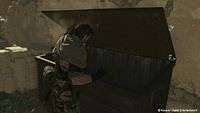Metal Gear Solid V: The Phantom Pain – Preview
by Edward
|
 When I was younger, there was almost nothing more appealing than the prospect of being a spy. A pre-adolescent version of myself relished the chance to don a tuxedo, drink vodka Martinis and tell everyone my name despite that being the very thing you should never do if you’re undercover. Then I was given a PlayStation and a copy of Metal Gear Solid, and my perception of spying changed forever. No longer was it about striding into the place with a cocksure arrogance and a book of quips at the ready; instead it was careful preparation, staying out of sight, and hiding inside the occasional cardboard box that helped save the day, and it was magnificent.
When I was younger, there was almost nothing more appealing than the prospect of being a spy. A pre-adolescent version of myself relished the chance to don a tuxedo, drink vodka Martinis and tell everyone my name despite that being the very thing you should never do if you’re undercover. Then I was given a PlayStation and a copy of Metal Gear Solid, and my perception of spying changed forever. No longer was it about striding into the place with a cocksure arrogance and a book of quips at the ready; instead it was careful preparation, staying out of sight, and hiding inside the occasional cardboard box that helped save the day, and it was magnificent.
Since then, the Metal Gear Solid franchise has spawned multiple blockbusters, spin-offs, constant threats of a movie adaptation, and has become so ubiquitous with stealth games that you can’t even mention the genre without thinking about Hideo Kojima, ten-minute-long monologues or getting the sudden urge to climb into a packing crate. Now we’re slowly sneaking up to the release of Metal Gear Solid V: The Phantom Pain, and it’s looking like everything a stealth fan could ever want.
After being put on ice for nine years since the events of Peace Walker and Metal Gear Solid V: Ground Zeroes, the story begins in 1984 when Big Boss’ ally Miller is kidnapped, spurring forth another grandiose tale of intrigue, betrayal, and endless philosophical musings. Plenty has changed since the Boss’ last outing, including the technology, his appearance, and even his name. Now taking on the moniker of Venom Snake, our hero also comes adorned with a red robotic arm and a black lump of metal sticking out of his skull. Looking more than a little worse for wear, he’s initially accompanied by series mainstay Ocelot, who’ll give the players an optional tutorial for those who want to acquaint themselves with the various mechanics at play.
 As the action seamlessly transitioned from cut-scene to gameplay, I couldn’t help but be impressed – cinematic moments in the series have always been built from the in-game engine, but would still be signalled by a fade to black and a lengthy loading time. Instead, the pass-over was instant and felt very immersive, which was either compounded or detracted by Snake’s horse choosing that moment to take a dump, depending on your comic sensibilities.
As the action seamlessly transitioned from cut-scene to gameplay, I couldn’t help but be impressed – cinematic moments in the series have always been built from the in-game engine, but would still be signalled by a fade to black and a lengthy loading time. Instead, the pass-over was instant and felt very immersive, which was either compounded or detracted by Snake’s horse choosing that moment to take a dump, depending on your comic sensibilities.
Travelling on horseback is just one of the many new mechanics that have been introduced, and it’s one which players should get well accustomed to if they want to explore the open-world environments to their fullest. Much like Ground Zeroes before it, areas are massively expansive, providing you tons of potential ways to explore and routes to take to your primary objective. While dismounting your steed and travelling on foot is an equally valid option, you’d be depriving yourself of another new way to play and sneak about the environment. Granted, riding a horse doesn’t seem like the most innocuous way to stealth, but Venom Snake can hang off the side of it in order to stay hidden from guards who feel compelled to look over to where all that galloping is coming from.
At this point, we were introduced to something new for the series – dynamic weather events. In this case, these came in the form of sandstorms, which Snake was given little time to react to before the entire area became enveloped. Visibility at this point is rather thin, and it’s entirely possible to accidentally alert enemies, which is, coincidentally, exactly what happened next. Here, we were shown a mechanic that some players took issue with when it was introduced in Ground Zeroes – instinct. When Snake catches the attention of enemies, the action will slow to a crawl, allowing you a brief few seconds with which to incapacitate them before they sound the alarm. While some may view it as cheap, to others it will become an all-important way to prevent potential frustration at being caught, although higher difficulties will eschew this mechanic to heighten the challenge.
 |
 |
 |
 |
 |
 |
Another feature making its return is the Fulton device, which was used in Peace Walker to air-lift soldiers back to your base in order to recruit them to your own private militia. In The Phantom Pain, this has been extended to allow you to not only capture people, but also vehicles and even sheep, if you’re into that sort of thing. They’ll even give an exasperated ‘baa’ as they’re flown away. It can even be used as a last-gasp escape method, so if you’re in the middle of a battle you can’t win, you can attach the Fulton to a crate or a Jeep, climb on top or inside and be safely flown back to your base of operations. Doing so will cause you to fail the mission, but it’ll also give you an extra opportunity to plan your next assault and let you live another day.
 Not only will using the Fulton give you more recruits to play with, but everything you air-lift back to Mother Base will give you resource points, which you can use however you see fit. Forcibly-enlisted enemies can be assigned to be part of your attack force or your Research and Development department, where they can help you develop new weapons and tactics to employ on the battlefield. In the demo, the points accrued were used to develop one of the most iconic items of the franchise – a cardboard box. Once it’s been created, the player can then choose where to have it dropped off, whether it be somewhere out of sight or – for example – on top of an unaware guard, allowing you to easily knock them down and thin out the enemy patrol.
Not only will using the Fulton give you more recruits to play with, but everything you air-lift back to Mother Base will give you resource points, which you can use however you see fit. Forcibly-enlisted enemies can be assigned to be part of your attack force or your Research and Development department, where they can help you develop new weapons and tactics to employ on the battlefield. In the demo, the points accrued were used to develop one of the most iconic items of the franchise – a cardboard box. Once it’s been created, the player can then choose where to have it dropped off, whether it be somewhere out of sight or – for example – on top of an unaware guard, allowing you to easily knock them down and thin out the enemy patrol.
If you start finding it hard to keep track of your foes, then another lifeline is afforded to you as Snake can now mark his enemies, with no apparent limit on how many soldiers can be tracked at any one time. Once they’ve been tagged, you’ll then be able to keep tabs on them, even to the point of being able to see them through walls, which may seem a bit too easy for some players, but will be more than welcome for others. Each guard will have their own routine as well, prompting the player to come up with different methods to dispatch each one if they don’t want to set off the alarms. They won’t walk around forever, either, and depending on the time of day, they can abandon their patrol in the name of catching up on their sleep and, knowing Kojima, you’ll probably be able to catch them unawares while they’re on the toilet, too.
Rather than be left at the behest of the new day-and-night cycle, players can manipulate it through Snake’s new Phantom Cigar, which will massively accelerate his perception of time, allowing you to switch between dawn and dusk in a matter of seconds. This also opens a whole new level of stealthing possibilities, as your visibility and the skills you can employ may vary depending on the time of day.
 What particularly intrigues me about most of the new features and mechanics present in The Phantom Pain is that they don’t immediately strike you as game changers, but once you’ve witnessed them it’s hard to imagine playing without them. They fit into the gameplay so seamlessly and compliment the action so perfectly that their inclusions all come across as no-brainers, despite the fact that their inclusion would potentially have been impossible before, due to technical limitations. Yet, every time you’re exposed to one of them you find yourself thinking ‘of course!‘, before naturally accepting it as part of the gameplay.
What particularly intrigues me about most of the new features and mechanics present in The Phantom Pain is that they don’t immediately strike you as game changers, but once you’ve witnessed them it’s hard to imagine playing without them. They fit into the gameplay so seamlessly and compliment the action so perfectly that their inclusions all come across as no-brainers, despite the fact that their inclusion would potentially have been impossible before, due to technical limitations. Yet, every time you’re exposed to one of them you find yourself thinking ‘of course!‘, before naturally accepting it as part of the gameplay.
Nowhere was this more apparent for me than when we were introduced to the new tricks Venom Snake can perform with his beloved cardboard box. While it’s still a mildly amusing way to traverse dangerous territory, it’s now a much more efficient method to get the drop on your enemies. For one, Snake can now pop out of the top of the box, take a potshot at someone and dive back inside before they know what’s hit them, allowing you to dispatch enemies from a distance while still being able to quickly utilise cover.
A moving cardboard box isn’t exactly the greatest disguise, however, and in previous games you’d often cause alarm if anyone saw your flimsy fortress scampering about the battlefield. In The Phantom Pain, however, Venom Snake has the ability to dive out of the side of the box at will, so if anyone sees it moving, you can abandon your cover, crawl away to another spot and then sneak up on your foe while he inspects the now-immobile cardboard. It’s a genius addition that feels like a perfect complement to the action, while simultaneously opening up a whole new world of strategy.
 |
 |
 |
 |
 |
 |
The same can be said for the new knocking mechanic as well. While each iteration of Snake has been able to knock on walls and alert nearby foes with the sound, players no longer need a solid surface to create a din. Now, players can use our hero’s robotic arm to cause a distraction, as clicking its wrist creates a loud noise that will cause anyone nearby to investigate. Our protagonist can also hide in dumpsters now, allowing you to climb inside, and use your CQC (close-quarters combat) skills to instantly knock them out and hide the body inside the container with you.
The action doesn’t stop once you’ve completed your objective any more, as you now have to find a way to escape the area with your life intact. As the mission drew to a close, Snake was discovered and set upon by a myriad of soldiers, whose numbers slowly dissipated once our hero called in an air-strike, although this only gave him a few seconds to evacuate the area if he didn’t want to be caught in the crossfire.
 Once out of the way of immediate danger, making your way to the rendezvous point is the new imperative, with our hero required to make his way to the exit vehicle – in this case a helicopter – and make a clean getaway. This becomes a lot harder if too many foes follow you, and just because you’ve stepped onto the helicopter doesn’t mean you’re out of harm’s reach. In this instance, Venom Snake hung out of the side of the chopper with a machine gun in hand, ready to shoot out anyone following them or trying to bring the bird down. In this case, most of the guards were wiped out by the air-strike, allowing Snake to quickly shut the door and relax on his journey back to the base.
Once out of the way of immediate danger, making your way to the rendezvous point is the new imperative, with our hero required to make his way to the exit vehicle – in this case a helicopter – and make a clean getaway. This becomes a lot harder if too many foes follow you, and just because you’ve stepped onto the helicopter doesn’t mean you’re out of harm’s reach. In this instance, Venom Snake hung out of the side of the chopper with a machine gun in hand, ready to shoot out anyone following them or trying to bring the bird down. In this case, most of the guards were wiped out by the air-strike, allowing Snake to quickly shut the door and relax on his journey back to the base.
Between missions, our hero can relax and customise what’s known as the Mother Base, the centre of your militia’s operations, and the perfect place to raise your soldiers. From here, you can leave your units to train themselves in the art of shooting and close-quarters combat, or you can personally train them yourself. You can also send them out on missions, use resource points to build new additions to your base, and even add defences to make it easier to stand your ground when enemies come to storm your fortress.
When it comes to stealth, there’s never been a franchise as utterly undisputed as the Metal Gear Solid series. Every chapter can manage to massively iterate on the last without rendering its predecessors obsolete, but still manages to feel familiar enough despite the incredible range of new mechanics and features on display. In this sense, The Phantom Pain is no different; it manages to introduce plenty of new ways to play and an open-world to explore while still possessing that same Metal Gear magic that permeates through every instalment. Every new addition to the gameplay feels like a stroke of innovation, and all the signs indicate that this will absolutely be the most in-depth, strategic and involving Metal Gear yet. When it comes to stealth, there’s no doubt that Kojima will still be wearing the crown when The Phantom Pain is released next year.
Last five articles by Edward
- Best of 2015: Journey's End: A New Beginning
- Journey's End: A New Beginning
- You Can't Choose Your Happy Ending
- Okay, Let's Fix Comedy In Games - The V-Effekt
- Time Keeps On Smashing Away

























There are no comments, yet.
Why don’t you be the first? Come on, you know you want to!